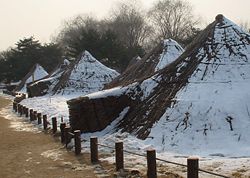Amsa-dong (Korean: 암사동) is a dong (neighbourhood) of Gangdong District, Seoul, South Korea.[1][2] The dong is well known for the Amsa-dong Prehistoric Settlement Site, in which Neolithic remains were excavated after a large amount of diagonal-line patterned earthenware(빗살무늬토기) was exposed by a flood in 1925.[3][4] It is thought to be a Jomonic settlement which existed prior to the spread of Songgukri-cultural sphere in Korean peninsula during the Korean bronze age. In Amsa Sam-dong, a festival named Amsa sunsa cultural festival is hold annually and parade is performed. It has a subway station of Seoul metropolitan subway 8th line, which functions as the last station of the line. There is only one high school in Amsa-dong named Sunsa highschool. The neighborhood is also known for its large traditional market. Amsa dong is divided in three, Amsa il-dong, Amsa I-dong, Amsa Sam-dong, and community centre is present in every one of these divisions..
Amsa-dong | |
|---|---|
| Korean transcription(s) | |
| • Hangul | 암사동 |
| • Hanja | 岩寺洞 |
| • Revised Romanization | Amsa-dong |
| • McCune–Reischauer | Amsa-tong |
 Amsa-dong Prehistoric Settlement Site | |
 | |
| Country | South Korea |
| Area | |
| • Total | 4.7 km2 (1.8 sq mi) |
| Population (2001)[1] | |
| • Total | 73,377 |
| • Density | 15,612/km2 (40,430/sq mi) |
See also
editReferences
edit- ^ a b 암사동 (Amsa-dong 岩寺洞) (in Korean). Doosan Encyclopedia. Retrieved 2008-04-18.[permanent dead link]
- ^ "The origin of Amsa-dong" (in Korean). Gangdong District official site. Retrieved 2008-04-18. [dead link]
- ^ "Amsa-dong Prehistoric Settlement Site". Korea Tourism Organization.
- ^ "Historical Attraction". KTDC. Archived from the original on 17 April 2008. Retrieved 2008-04-18.
External links
edit- (in Korean) The Amsa 1 & 4 dong Resident office